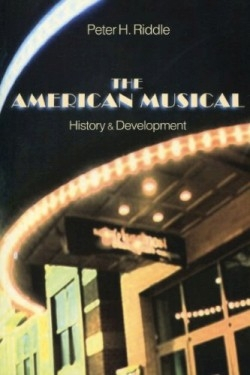The American Musical
History & Development
From the memorable songs of Oklahoma! to the recent phenomenal success of The Producers, musicals are a particularly American form of theatre. The author, who teaches music at Arcadia University in Nova Scotia, provides a helpful overview of the people, places, and events that have given—and continue to give—American musical theatre its character.
Riddle opens his history by examining North America’s first musical theatrical hit, The Black Crook, which opened in New York in 1866 and ran for 475 performances. Each performance lasted more than five hours, combining music, drama, melodrama, ballet, and opera with alluring (by Victorian standards) costumes and spectacular props, including a simulated hurricane.
In the early twentieth century, a variety of musical theatre forms—from the minstrel show to the operetta to vaudeville revues—prepared the ground for the astonishing development of musical theatre on Broadway. Riddle points out that the musical soon evolved into a type of dramatic show in its own right, establishing the careers of a number of famous composers and writers.
In 1927, Oscar Hammerstein launched a new era of American musical theatre with his groundbreaking Show Boat. According to Riddle, who holds a Ph.D. from Southern Illinois University and has published ten previous non-fiction books and three novels, Hammerstein’s play “carried the concept of plot/music fusion to a new level. Each of its musical numbers flows naturally out of the preceding dialog and action. Not only do they convey and drive the tale, they provide the audience with insight into the characters’ lives and thoughts.”
The success of Show Boat encouraged other composers and writers to follow in Hammerstein’s steps; thus, the greatest era of American musical theatre developed through Rodgers and Hart (Babes in Arms), George and Ira Gershwin (Porgy and Bess), Cole Porter (Jubilee), Leonard Bernstein (West Side Story), Rodgers and Hammerstein (Oklahoma), Stephen Sondheim (A Funny Thing Happened on the Way to the Forum), and Andrew Lloyd Weber (Jesus Christ Superstar).
Although the American musical seemed to lie dormant during the 1970s and 1980s, the tremendous popularity of productions such as 42nd Street, Mamma Mia, The Lion King, and The Producers indicates that audiences continue to seek a little entertainment with their melodrama. Riddle also examines the kinds of songs that make up the American musical, from the “patter song” and the “age-related song” to the “what-if song.”
This fine, entertaining little book offers readers a chance to experience once again the excitement and glorious pageantry of American musical theatre. Riddle’s encyclopedic treatment of the musical provides a panoramic view of the history of theatre, offering not only a glimpse at the roots of musical theatre but also at the genre’s continuing grip on twenty-first-century audiences. Fans of the American musical will find this an informative, delightful portrait of the genre.
Disclosure: This article is not an endorsement, but a review. The publisher of this book provided free copies of the book to have their book reviewed by a professional reviewer. No fee was paid by the publisher for this review. Foreword Reviews only recommends books that we love. Foreword Magazine, Inc. is disclosing this in accordance with the Federal Trade Commission’s 16 CFR, Part 255.

